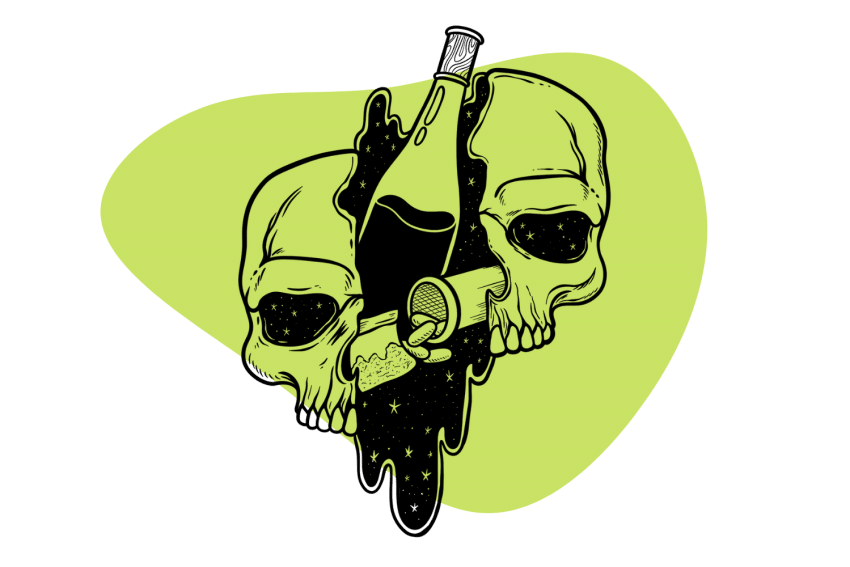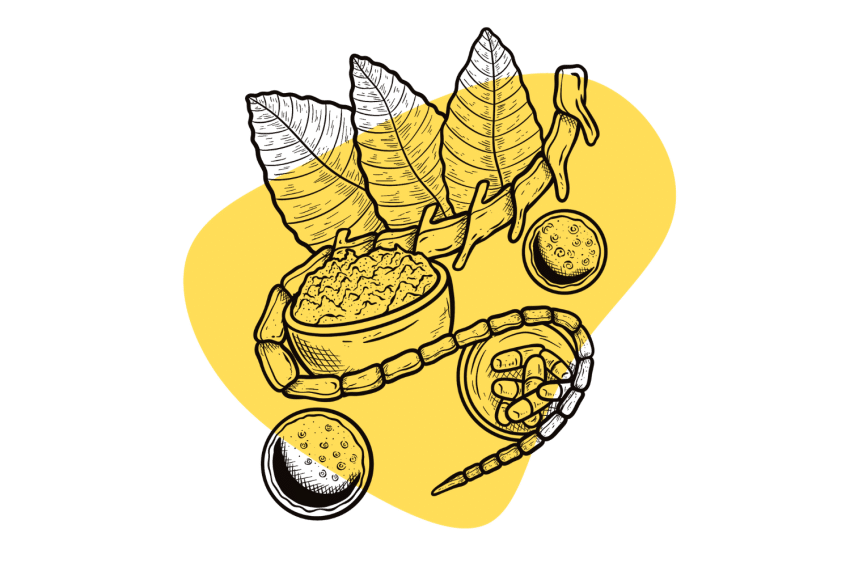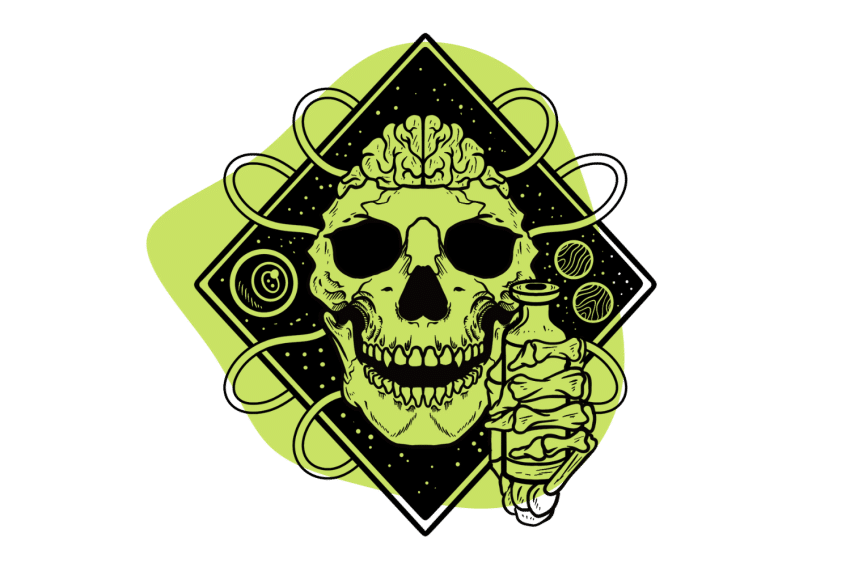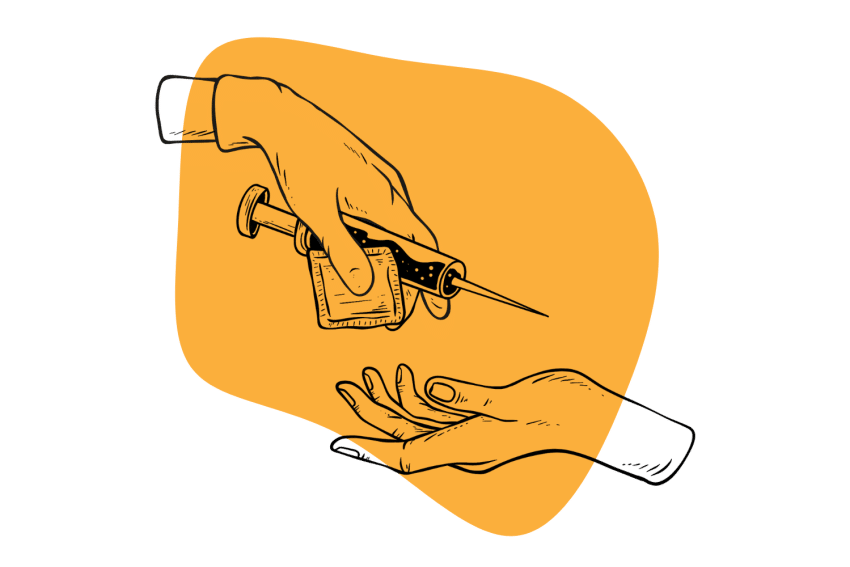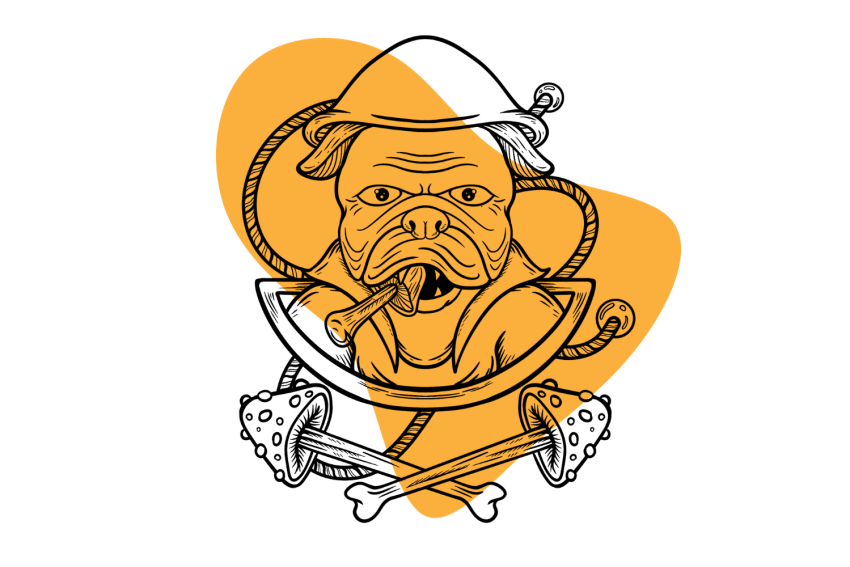How To Test Psychoactive Substances With Drug Testing Kits & Reagents
There’s always going to be some inherent risk that your psychedelics could be laced with harmful compounds. Test kits are designed to detect these hidden substances before you take it.
Unless you’re using a raw plant for fungi — where you can visibly see the product you’re using, you’re going to need to test the sample to know whether the drug is what you think it is.
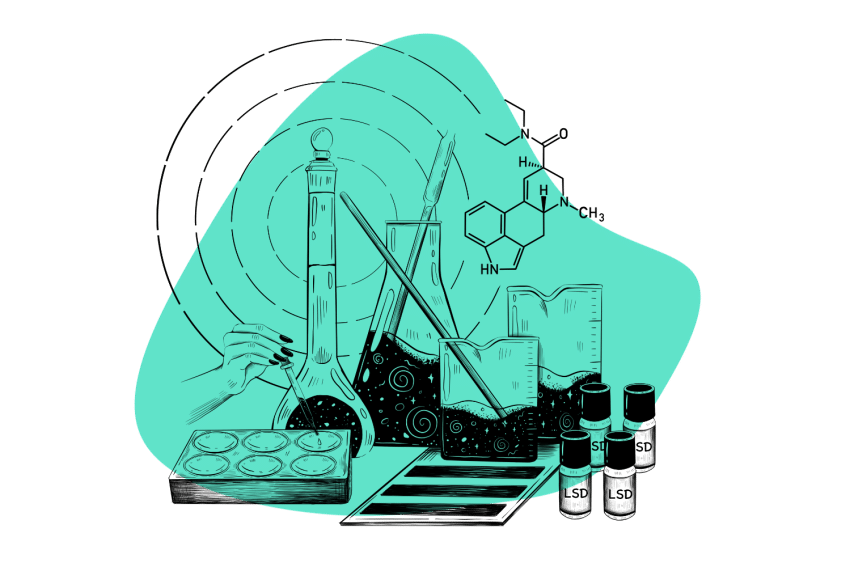
Testing isn’t perfect, but it can dramatically reduce the potential for harm when using psychedelics.
Testing psychedelic compounds is one of the core components of responsible psychedelic use.
You only need a tiny sample of your substance and a $30 kit to run the test. Each kit provides enough reagent for 100 tests (or more).
This article will highlight the process for testing the following substances:
Key Takeaways: Drug Reagent Testing
- You only need a tiny sample of the substance you’re testing
- You only need one drop of test reagent
- You should always run two different tests, more is better but optional
- Testing takes 2 minutes to perform
How to Test Your Substances
These tests are super simple to perform. Just place a small sample on a clean plate. Drop one drop of solution on the sample and see what color it changes too.
Easy as that.
For a more detailed breakdown of each step, keep reading.
Step 1: Prepare Your Sample
You don’t need much to run the test — only about an eighth of a tab of acid or a sample the size of a pencil tip for crystalline or powdered substances.
You need a sample for each test you want to run.
Place each half onto separate ceramic plates. It’s best to use a white ceramic so you can see the color change more clearly. Avoid placing the sample onto metal, wood, or plastic to avoid cross-contamination with other elements or substances.
Ceramic or glass are the best because they’re completely inert.
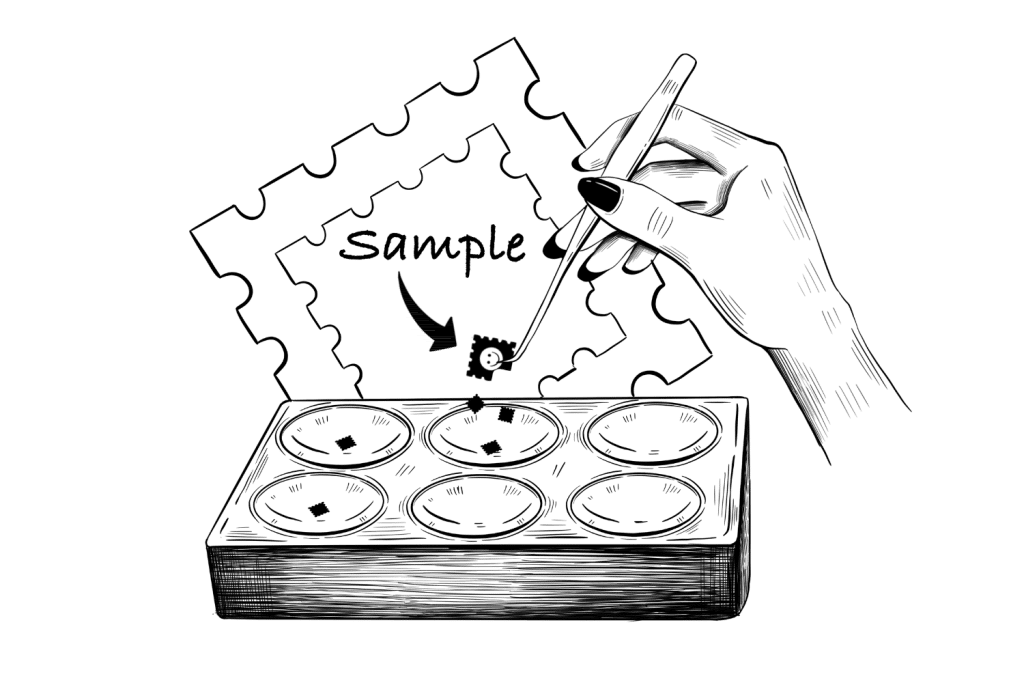
Step 2: Place One Drop of Testing Solution Per Test
For every test you want to run, you need a separate sample. It’s always a good idea to run at least two tests to properly rule out dangerous adulterants.
Place a single drop of the reagent on the sample, and wait a few seconds.
Wait for the sample to react — it will either change color, or it won’t. Use the included color charts (see below) for each test to determine the results.
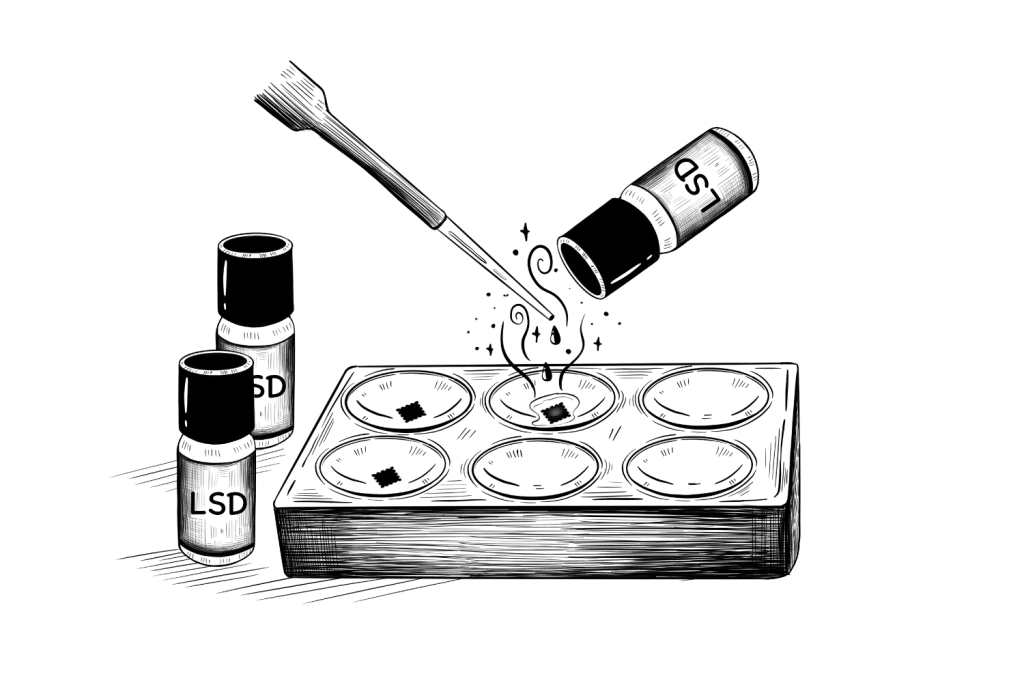
Step 3: Interpret The Results
There are many different types of drug reagents, each one with their own color guide — so it’s critical that you stick to the color panel for the specific type of test you’re running.
Hold the color guide next to your sample, and wait about 10–30 seconds before taking your reading. This ensures the reagent and substance have enough time to react together to produce the final results.
You can find standard color charts for various drug reagents online or using some of the resources below — but in most cases it’s safest to use the color charts provided by the specific manufacturer of the test kit you’re using.

Psychedelic Testing: Cheat-Sheet
You can test just about any pure compounds or tablets with reagent test kits. It won’t work for organic materials like mushrooms, or peyote, nor will it work to determine the contents of complex mixtures.
Here’s how to test some of the most common psychedelic substances.
| Name | Marquis | Mecke | Mandelin | Liebermann | Froehde | Ehrlich | Hofmann | Simon’s |
| 1P-LSD | Reddish purple | Brown | No Reaction | No Reaction | No Reaction | No Reaction | No Reaction | No Reaction |
| 2C-B | Yellow then Green | Yellow then Brown | Green | Yellow then Black | Yellow then Green | No Reaction | No Reaction | No Reaction |
| 2C-B-FLY | Dark Brown | Yellow then brown | Brown | Yellow then Brown | Yellow then Brown | No Reaction | Yellow | No Reaction |
| 2C-C | Yellow then Green | Tellow green then Brown | Yellow then green | Dark Green or Yellow | Yellow then Green | No Reaction | No Reaction | Greenish Black |
| 2C-D | Yellow-Brown | Green-Brown | Green | Black, then yellow | Yellow then green | No reaction | light yellow | Greenish black |
| 2C-E | Dark yellow then orange | Yellow then Dark Green Then Brown | Green | Green then dark brown | Yellow | No Reaction | Light Yellow | Greenish Black |
| 2C-I | Dark Green then Black | Brown then Black | Brown then Black | Black | Orange then Black | No Reaction | Light Yellow | No Reaction |
| 2C-iP | Orange then Red | Brown then Green | Green | Dark Green or Yellow | Light Green | No Reaction | Light yellow | No Reaction |
| 2C-P | Yellow | Yellow-green — Then Brown | Green | Green | Froehde | No Reaction | Light Yellow | No Reaction |
| 2C-T-2 | Pale Orange | Orange, then Red, then Purple | Purple | Red or Purple | Orange then Purple | No Reaction | No Reaction | No Reaction |
| 2C-T-7 | Pale Yellow | Orange then Black | red then Black | Deep Purple | Violet then orange | No Reaction | No Reaction | No Reaction |
| 2C-TFM | Yellow then Brown | Dark Green | Green | Dark Green | Greenish yellow or Brown | Green, yellow, or brown | No Reaction | No Reaction |
| 4-AcO-DMT | Yellow then green then Brown | Yellow then dark green | Yellow then black | Brown then black | Green then Black | Light purple | Yellow | No Reaction |
| 5-MeO-DMT | Yellow | Red/Brown | Greenish brown | Black | Yellow | Purple | Green | No Reaction |
| AL-LAD | No Reaction | No Reaction | No Reaction | No Reaction | No Reactionq | Pink | No Reaction | No Reaction |
| ALD-52 | No Reaction | No Reaction | No Reaction | Yellow | No Reaction | No Reaction | No Reaction | No Reaction |
| DPH | No Reaction | No Reaction | No Reaction | No Reaction | Orange | No Reaction | No Reaction | No Reaction |
| DXM | Grey then Black | Yellow | Light Brownish Green | Black | No Reaction | No Reaction | Yello | No Reaction |
| ETH-LAD | No Reaction | No Reaction | No Reaction | No Reaction | No Reaction | Pink | Blue | No Reaction |
| LSD | No Reaction | No Reaction | No Reaction | No Reaction | No Reaction | Purple | Blue | No Reaction |
| MDMA | Dark Purple | Black | Black | Black | Dark Blue | No Reaction | No Reaction | Dark Blue |
| N,N-DMT | Brown | Dark Green | Brown | Black | No Reaction | Purple | Yellow | No Reaction |
| Proscaline | Orange Red | Yellow then brown | brown then black | Brow then Black | Yellow then Green | No Reaction | No Reaction | No Reaction |
1. How to Test LSD
Testing kits for LSD (lysergic acid diethylamide) involve two test reagents — the Ehrlich reagent and the Hoffmann reagent.
The Ehrlich reagent is the primary test for LSD. This will detect the presence of an indole alkaloid — which would only refer to a DMT analog or lysergamide. If indoles are present, the sample will turn purple.
Most indole alkaloids have a high incidence of safety.
To differentiate DMT (dimethyltryptamine) compounds from LSD, use the Hofmann reagent. It may turn green (5-MeO-DMT), yellow (N,N,DMT), or purple/blue (LSD).
If neither of these tests registers, don’t take the tab. There are only a few substances potent enough to provide psychoactive effects with such a small dose. Unfortunately, most of the non-indole compounds are dangerous (NBOMes, & DOX compounds, for example).
These tests can also be used to differentiate other lysergamides — such as AL-LAD, PRO-LAD, ETH-LAD, ALD-52, LSZ, and 1P-LSD. This may take some interpretation, however.
What to expect if your sample contains LSD:
- Ehrlich — Purple
- Hofmann — Blue
LSD Adulterants to Watch Out For:
→ Buy this testing kit for LSD
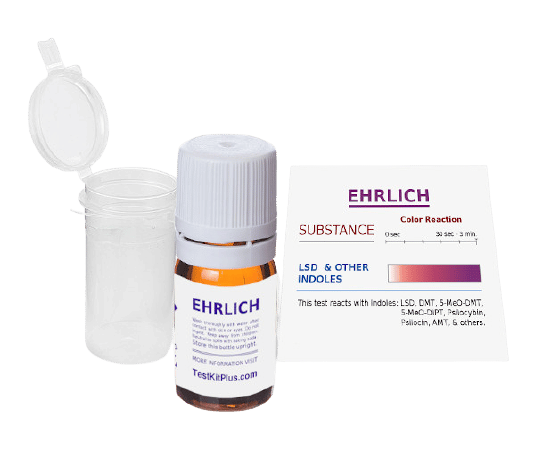
2. How to Test DMT
DMT (dimethyltryptamine) is an indole alkaloid, so the main chemicals used to test it are the Ehrlich and Hoffman reagents.
The rest are mainly used to confirm the absence of other substances. The Ehrlich will confirm the substance is an indole, the Hofmann will then turn yellow for N,N,DMT,, green for 5-MeO-DMT, or purple for lysergamides.
Here’s what to expect if your sample contains DMT:
- Ehrlich — It should turn purple within 2 minutes.
- Hofmann — Should turn green (5-MeO-DMT) or yellow (N,N,DMT).
- Marquis — Should change yellow.
- Mecke — Should turn red-brown.
- Mandelin — Should turn greenish-brown.
3. How to Test MDMA & Amphetamines
MDMA is the active ingredient in ecstasy — however, most ecstasy tablets these days contain several different compounds. Some of the most concerning are PMA, PMMA, cathinones, fentanyl, or other opiates.
The first reagent is the Marquis reagent. This is used to determine if the sample contains amphetamines such as MDMA, MDA, MDE, methamphetamine, or other amphetamine substances. It should turn dark purple or black if the sample contains MDMA, MDA, or MDE.
If there is no change or if the sample turns a blue color, it means your sample is not MDMA, MDA, or MDE and should be discarded immediately.
The Simon’s reagent is then used to differentiate between MDMA and the closely related compounds MDA and MDE.
Place a drop on the third sample and watch for a change. It should change immediately. If the sample consists of MDA, 5-APB, 6-APB, it won’t change color. If your sample consists of MDMA or MDE, it will turn a blue color.
Here’s what to expect if your sample contains MDMA:
- Marquis — Black
- Mecke — Blue/black
- Mandelin — Black
- Liebermann — Brown
- Froehde — Dark blue
→ Buy this testing kit for MDMA
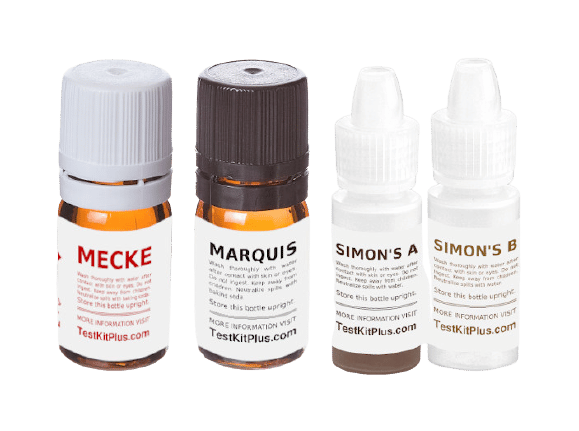
4. How to Test Ketamine
The simplest test to run for ketamine is the Mandelin reagent.
If your sample is ketamine, it will turn a deep orange color. If it changes any other color or doesn’t react at all — it’s not ketamine and should be avoided completely.
This test will turn brown if the sample contains PMA or PMMA (toxic) or MDPV (synthetic cathinone). The sample will turn green if it consists of MXE (another dangerous ketamine alternative).
You can follow up with the Marquis reagent to test for cathinones (will turn yellow) or MDMA, MDA, and MDE (purple).
The Mecke test can also be used to test for opiates. It will turn yellow if the sample is DXM or bluish-green if it consists of opiate drugs instead.
Ketamine itself isn’t considered to have a high level of risk — but because of its black-market nature, there’s a lot of unethical manufacturers and vendors selling other compounds like DXE, PCP, 2-FDCK, MXE, O-PCE, and any number of other potentially dangerous research chemicals.
What to expect if your sample contains ketamine:
- Mandelin — Orange/red
- Liebermann — Light yellow
- Mecke — No reaction
- Simon’s — Yellow
→ Buy this testing kit for ketamine
→ Check out this three-in-one testing kit, which includes all three reagents mentioned above.
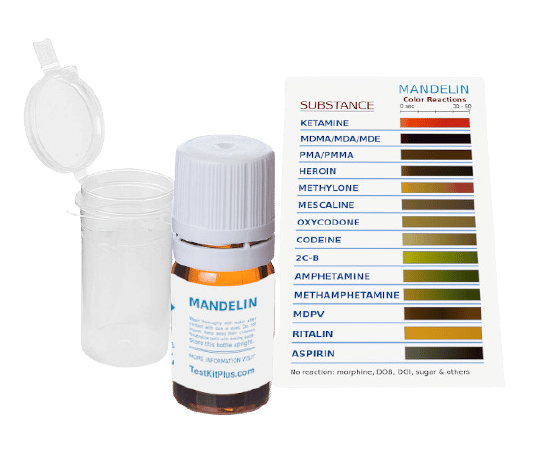
5. How to Test Mescaline & 2C-X Compounds
Mescaline is the most prevalent of the psychedelic phenethylamines. It’s the active compound in the peyote, San Pedro, and Peruvian Torch cacti. Synthetic mescaline is also common and readily available on the black market in most parts of the world.
Other psychedelic phenethylamines include the 2C-X family of drugs — which includes members such as 2C-B, 2C-C, and 2C-D. These compounds are very similar to mescaline, so the testing protocols overlap quite a bit.
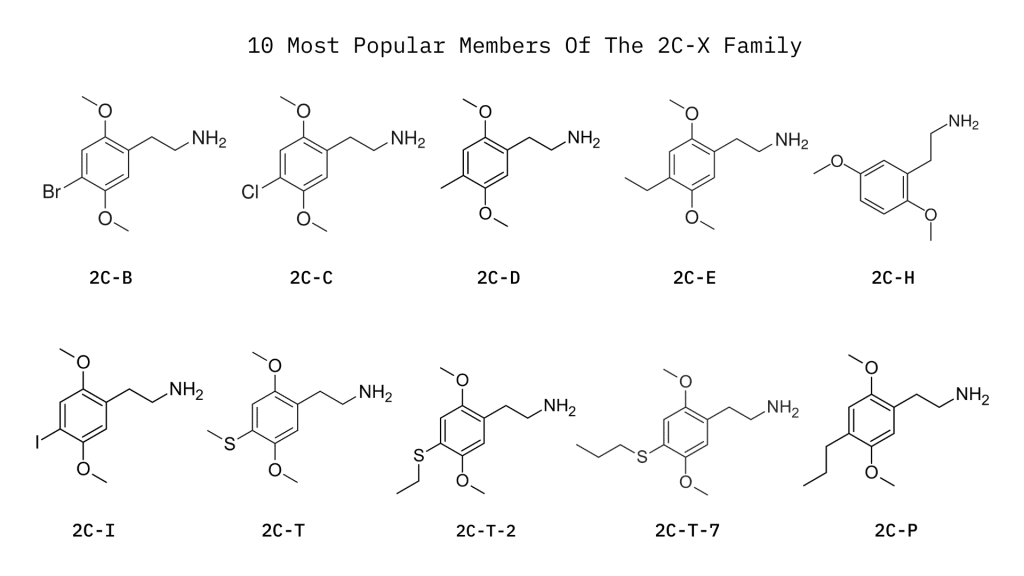
The main reagent for testing mescaline & 2C-X is the Marquis reagent. If the sample contains mescaline, it will change to a bright red color.
If the color turns to a yellow-green color, it’s 2C-B.
If there is no change in color, or it turns red, purple, black — it’s something completely different.
Testing 2C-B and other 2C-X compounds follows the same process.
The main concern you’re looking for when testing 2C-X is to make sure the sample you’re using doesn’t contain any opiate medications or NBOMes using the Mecke and Mandelin reagents, respectively.
What to expect if your sample contains mescaline:
- Marquis — Orange
- Mecke — Brown
- Mandelin — Brown
- Liebermann — Black
- Froehde — Yellow
What to expect if your sample contains 2C-B:
- Marquis — Green
- Mecke — Brown
- Mandelin — Green
- Liebermann — Black
- Froehde — Green
- Ehrlich — No reaction
- Folin — Purple
→ Use the Marquis or Three-In-One Testing Kit
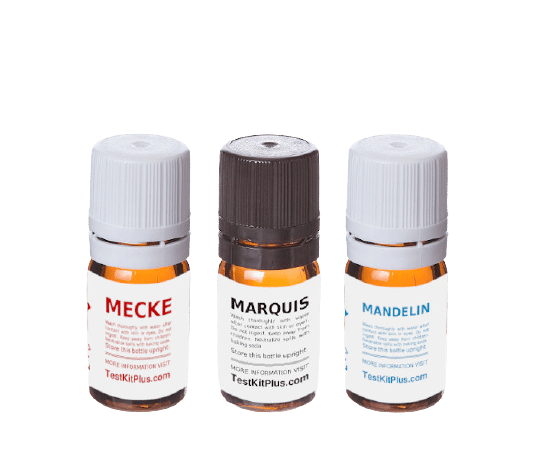
List of Reagent Test Chemicals
The best way to test substances at home is to use reagent chemicals.
Reagents test drops consist of chemicals that react and change color in the presence of specific compounds.
- Marquis — Used to detect amphetamines.
- Simon’s — 2-parts. Differentiates MDMA from MDA
- Froehde — Detects alkaloids (mostly opioids)
- Liebermann — Can detect cocaine, morphine, PMMA, and cathinones.
- Mandelin — Used to differentiate some alkaloids.
- Mecke — Detects the presence of opiates.
- Ehrlich — Used to detect indole alkaloids.
- Hofmann — Used to differentiate lysergamides from DMT.
- Mecke — Used to detect the presence of opioids.
A reagent test liquid can only detect the presence of a compound — not its concentration.
Tablets or powders that have a low purity or contain a variety of different ingredients can lead to false negatives or false positives. No reagent test is guaranteed — they merely offer a level of risk reduction. They cannot guarantee that the substances you’re using are completely safe.
The chemicals in reagent liquids are often toxic. You should handle them with care and never allow the compound to contact the skin. Wear gloves and keep some baking soda nearby to neutralize the chemical if it gets onto your skin or another surface. You should also add baking soda to your test sample when you’re done before disposing of it.
Always put the lid on the reagent bottle immediately after you’re done. Mixing the caps can cause cross-reaction and ruin the testing chemical.
Some reagent testing calls for only one test — but it’s always better to do two or more tests with different reagents to be extra cautious and to help rule out other potential adulterants in your substances.
1. Marquis Reagent
The Marquis reagent is the primary test for assessing MDMA or ecstasy. It’s used to detect opiates (such as codeine, heroin, or fentanyl) and phenethylamines (2CB or mescaline). This reagent is a mixture of formaldehyde and concentrated sulfuric acid.
This reagent will darken during storage over time — but it will still work.
The Marquis reagent will identify the presence of compounds, including mescaline, 4-ACO-DALT, 2C-P, 2C-D, 2C-E, 25D-NBOMe, TMA-6, DOC, 2C-B, 2C-C, 2C-B-FLY, DOB, BK-2C-B, proscaline, mescaline, 25iP-NBOMe, allylescaline, 25N-NBOMe, 25E-NBOMe, 25B-NBOMe, 25I-NBOME, 4-HO-MET, DOM, 5-MeO-AMT, 2C-I, AMT and more.
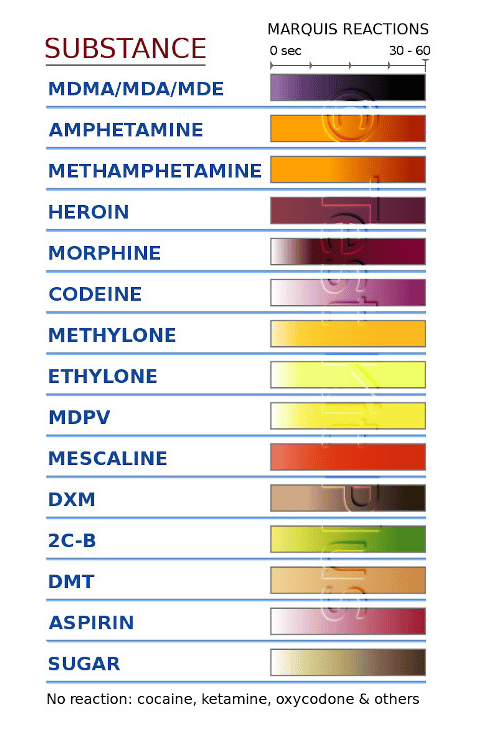
2. Simon’s Reagent
This reagent is used to differentiate MDMA from MDA. It consists of two parts (A and B). The two solutions are each dropped onto the testing sample to combine them together. Part A consists of sodium nitroprusside and acetaldehyde in water. Part B contains sodium carbonate in water.
3. Froehde Reagent
The Froehde reagent consists of a mixture of molybdic acid or a molybdate salt dissolved in hot, concentrated sulfuric acid. It’s used to determine the presence of many alkaloids — primarily opiates.
The Froehde reagent will identify the presence of 25B-NBOMe, 25iP-NBOMe, 25C-NBOMe, 25E-NBOMe, 2C-B, 2C-C, 2C-B-FLY, 2C-BZ, DOB, TMA-6, 4-AcO-DALT, 4-HO-MET, 4-HO-MIPT, mescaline, 25I-NBOMe, BK-2C-B, allylescaline, 2C-I, 25N-NBOMe, proscaline, 5-MeO-MiPT, 5-MeO-AMT, and more.
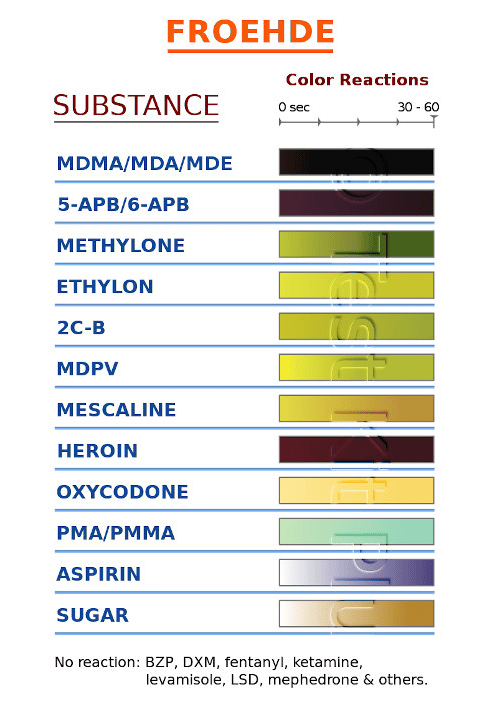
4. Liebermann Reagent
This reagent is used to identify the presence of alkaloids in a sample. It’s composed of potassium nitrite and sulfuric acid. The most common applications of this test are to check for substances, including cocaine, morphine, PMA, and PMMA. It’s used to differentiate between a few different cathinones (bath salts) and to identify levamisole in cocaine.
Liebermann reagent will determine the presence of MDMA or MDA. MDE, amphetamine, methamphetamine, methylone, ethylone, 2CB, PMA, PMMA, ephedrine, ketamine, mescaline, DMT, heroin, levamisole, aspirin, and more.
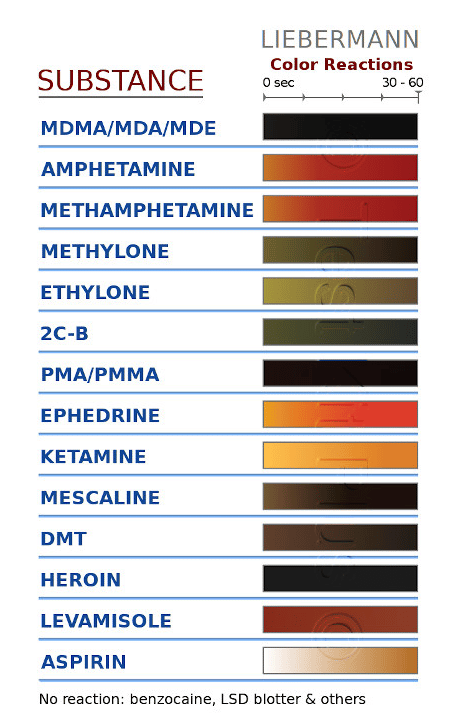
5. Mandelin Reagent
The Mandelin reagent is used to differentiate or identify the presence of a variety of different alkaloids. It consists of a mixture of ammonium metavanadate and concentrated sulfuric acid. The main use of this reagent is to test for the presence of ketamine and PMA or PMMA.
The Mandelin reagent will determine the presence of ketamine, MDMA, MDA, MDE, PMA, PMMA, heroin, methylone, mescaline, oxycodone, codeine, 2CB, amphetamine, methamphetamine, MDPV, Ritalin, aspirin, and more.
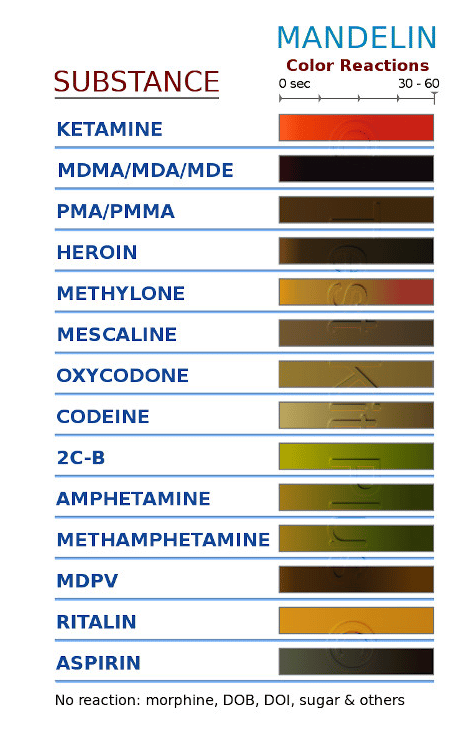
6. Mecke Reagent
The Mecke test is primarily used to check for the presence of opiates. It consists of a mixture of selenous acid and concentrated sulfuric acid. It’s sometimes used as an alternative to the Marquis reagent.
This reagent will darken during storage over several months or years — but it will still work.
The Mecke reagent will identify compounds including mescaline, 25C-NBOMe, 2C-B, 4-HO-MiPT, DOB, DOM25E-NBOMe, 2C-B-FLY, 4-AcO-DALT, 2C-C, 25D-NBOMe, 25iP-NBOME, BK-2C-B, TMA-6, 25I-NBOMe, 5-MeO-AMT, 25N-NBOMe, 25B-NBOMe, 2C-iP, 2C-P, allylescaline, 5-APB succinate, mescaline, 2C-D, 2C-I, 4-HO-MET, proscaline, 3C-E, 2C-E, and DOC
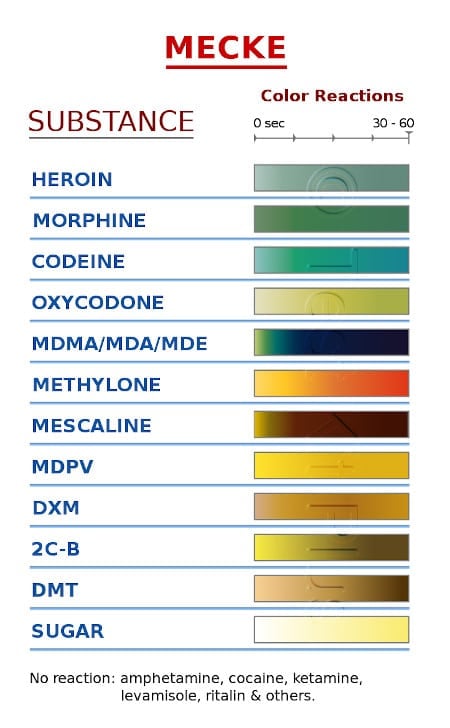
7. Ehrlich Reagent
Ehrlich’s reagent contains p-dimethylaminobenzaldehyde (DMAB). It’s used to detect indole alkaloids, which include common psychedelic compounds such as LSD, DMT, 5-MeO-DMT, 5-MeO-DIPT, psilocybin, psilocin, AL-LAD, and AMT. It can’t be used to differentiate between these compounds.
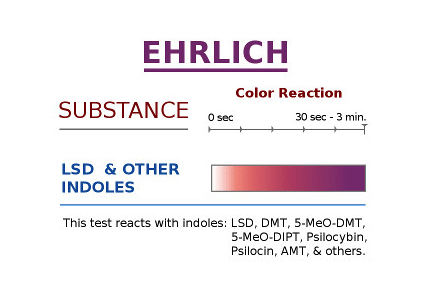
8. Hofmann Reagent
The Hofmann reagent is very similar to Ehrlich for determining the presence of indole alkaloids. It’s slightly different and reacts with different colors to various compounds. It’s primarily used to detect and differentiate DMT from other indole compounds like LSD or psilocybin. This reagent will even differentiate between 5-MeO-DMT and DMT (green vs. yellow, respectively).
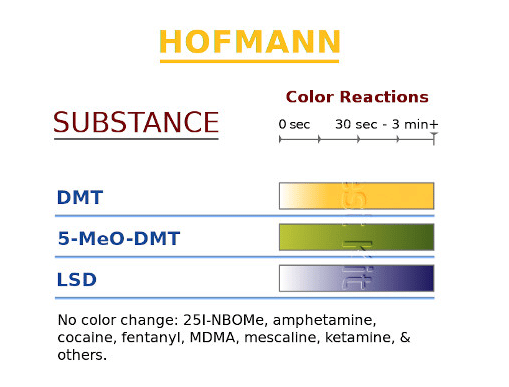
How to Store Drug Test Reagents
You can run over a hundred tests with a single 10 mL bottle of reagent, so it’s worth spending the effort to store them correctly, so they remain viable for many years.
If you’re using your drug reagents often, store them in a cool, dark location.
If you don’t plan to use them often and want to get the maximum shelf-life out of them, store them in the freezer in a sealed freezer bag. make sure you allow them to thaw before you run the test. Some reagents will freeze and won’t work properly until they’re fully melted.
Avoid mixing the caps up by screwing the lid back on immediately after using it.
Summary: How & Why You Should Test Your Substances
Testing your drugs before you start is a core aspect of responsible psychedelic or substance use. It’s especially important for synthetic psychedelics in which you can’t directly see the compound you’re taking in raw form (such as using psychoactive fungi, cacti, or plants).
You should never assume a substance is what you think it is until you’ve tested it. It’s common for people to order a substance thinking it’s LSD, MDMA, mescaline, or ketamine — when in reality, it’s some other research chemical.
The nature of buying these drugs on the black market brings an inherent level of risk. Unethical manufacturers often sell compounds like NBOMe in place of acid, MDX, or PCP in place of ketamine because they’re cheaper to produce. None of these adulterants are considered safe.
There are also hundreds of other, poorly understood research chemicals being sold around the world under the guise of more well-known substances.
Testing is the only way to identify the compound you intend to use. It’s cheap to do and only requires a small sample to run the test. There isn’t any reason not to test your drugs when the bar to doing it is so low, and there’s so much to gain from doing it.

